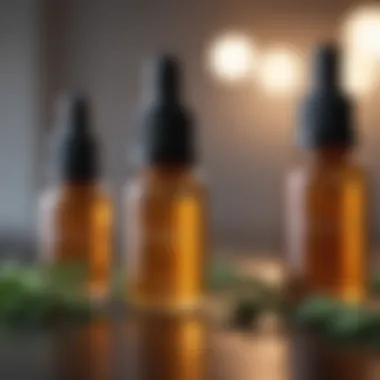Essential Oils for Stimulating Hair Growth Naturally


Intro
Essential oils have become prominent in hair care discussions, particularly in fostering hair growth. These concentrated extracts from plants contain numerous compounds that can enhance scalp health and stimulate hair follicles. Studies suggest that the use of essential oils may significantly influence hair growth cycles and overall scalp wellness.
Increasing our knowledge of how these oils function is key. We must understand the efficacy of specific essential oils, such as rosemary, lavender, and peppermint, which have shown potential not just in marketing but scientifically too. Understanding how to properly integrate these oils into hair care routines, while being mindful of safety concerns, allows individuals to make educated choices about their personal care strategies.
Well-Being Overview
Exploring natural solutions for hair growth resonates with many seeking alternatives to chemical treatments. Focusing on essential oils creates an intersection between health, wellness, and self-care. This deeper dive into an organic approach highlights the personalized nature of beauty and health.
By embracing these natural products, individuals not only pursue improved hair aesthetics but also prioritize well-being. This perspective involves recognizing that healthy hair often reflects broader health practices, including dietary choices, mental health care, and maintaining a balance between work and relaxation.
In concluding, this journey into essential oils for hair growth reflects a growing importance of holistic well-being. The subsequent sections will illuminate each oil's benefits—mechanisms of action, safety considerations, and practical incorporation methods—offering readers a comprehensive, well-rounded view to nourish both hair and health effectively.
Intro to Essential Oils and Hair Health
Essential oils have become prominent in conversations about hair care and health. These natural extracts from plants offer potential benefits for hair growth and overall scalp wellness. This section clarifies essential oils and their importance to hair health, shedding light on their role in revitalizing hair and addressing common hair-related issues.
Understanding Essential Oils
Essential oils are concentrated liquids comprising volatile aromatic compounds derived from plants. These oils are known for their distinct fragrances and healing properties. They are often used for various purposes, including aromatherapy, skin care, and, notably, hair care. The appeal of essential oils lies in their ability to synergize with the body's natural processes. Thus, they are valued not only for pleasant scent but also for potential health benefits on hair and scalp.
While many people brush aside the notion of using oils for hair health, understanding their functional components provides insight into their efficacy. Components like terpenes, phenols, and esters found in essential oils can stimulate scalp circulation, strengthen hair follicles, and promote growth.
The Science Behind Hair Growth
Hair growth is a complex biological process that involves multiple phases: anagen (growth), catagen (transition), and telogen (resting). Essential oils impact this process primarily through their interactions with the scalp's biology. Their stimulating effects enhance blood flow to hair follicles, facilitating nutrient delivery.
Research indicates that essential oils can encourage hair growth by addressing specific concerns such as inflammation, hormonal imbalances, and nutrient deficiencies. Various scientific studies suggest that oils like rosemary and peppermint can not only promote healthier hair follicles but enhance overall scalp health.
“The application of essential oils can support hair growth through their properties, including anti-inflammatory and antibacterial effects.”
Key Essential Oils for Hair Growth
Essential oils have gained recognition for their potential benefits in promoting hair growth. Each oil interacts with hair and skin uniquely, addressing various issues that can lead to hair loss or thinning. The incorporation of these oils not only enhances the hair condition but may also improve scalp health. Understanding how to effectively use these oils is vital for maximizing their benefits.
Rosemary Oil
Mechanism of Action
Rosemary oil's primary mechanism relates to its stimulation of blood circulation on the scalp. This enhanced blood flow delivers essential nutrients to hair follicles, promoting healthier growth. Moreover, rosemary oil contains ursolic acid, which possesses anti-inflammatory properties. This characteristic makes it an effective choice, as it can reduce scalp irritation and enable better absorption of nutrients that are crucial for hair growth. Furthermore, the unique feature of rosemary oil is its ability to inhibit the production of dihydrotestosterone (DHT), a hormone closely linked to hair loss in both men and women. The advantages are clear: using rosemary oil regularly can support improved follicle health.
Application Methods
The application of rosemary oil maintains its efficacy when done correctly. Common methods include diluting the oil with a carrier before massaging it into the scalp. This approach not only ensures safe usage but also enhances the oil's absorption. A beneficial practice is conducting weekly treatments, as consistent application can amplify results. Users might mix it with other oils like jojoba or coconut for added moisture, which boasts additional conditioning properties. One consideration is that undiluted essential oils can cause irritation, emphasizing the need for careful application.
Peppermint Oil
Studies Supporting Efficacy
Research backs the effectiveness of peppermint oil in promoting hair growth. A key study found that a topical application of peppermint oil increased hair growth on model test subjects due to improved circulation and increased dermal thickness. This characteristic proves peppermint oil as a credible choice for hair care aims. However, while laboratory results are promising, more extensive studies on human subjects are crucial to solidifying the claims. One unique feature of peppermint oil is its refreshing scent along with its hair growth properties, providing an calming application experience.


Usage Guidelines
For maximum efficacy, it's advised to dilute peppermint oil before applying it to the scalp. Typically, a concentration of 2% is standard. Application can involve taking a few drops, mixing with a carrier oil, and massaging it into the scalp for 10-15 minutes before rinsing. This method allows the oil's benefits to take effect without overwhelming the scalp's sensitivity. Another aspect is the use of peppermint-infused shampoos, which provide an alternative method of integration. Overuse can lead to skin irritation or an overheating sensation, so moderate approaches should be reminded.
Lavender Oil
Benefits for Scalp Health
Lavender oil offers multiple benefits for hair and scalp health. This oil is well known for its antimicrobial and anti-inflammatory properties. As a result, it can potentially prevent scalp infections that hinder hair growth. Additionally, it is noted for its ability to improve moisture retention in the scalp, and its soothing aroma can also help relieve stress, which indirectly impacts hair loss. Users should note, however, lavender oil should be used judiciously, as very high concentrations have possible side effects.
Mixing with Carrier Oils
Mixing lavender oil with a carrier oil enhances its application abilities. Common carriers include almond oil or coconut oil which protect the scalp while benefiting from rosemary oil's characteristics too. This practice not only dilutes the potency, ensuring safety but also combines the nutritional profiles of both oils for enhanced effect. Usually, a combination of 3-5 drops of lavender with a teaspoon of carrier oil is advised.
Cedarwood Oil
Supporting Hair Follicle Health
Cedarwood oil aids in fortifying hair follicles, selectively improving hair thickness while reducing hair loss. The oil's strong antifungal and antibacterial beneficial properties can reduce scalp issues contributing to hair loss. Plus, its stimulating effects can lead to improved hair growth over time, making it a solid choice for wellness coaches and health professionals. However, individual results may vary, and often, a period of consistent application is needed before observing significant changes.
How to Apply
Cedarwood oil should be diluted before application to minimize the chance of irritation—mixing it at a ratio of about 4-6 drops per tablespoon of carrier oil is common. Massaging it gently onto the scalp should be done for several minutes, promoting relaxation and better absorption. This method encourages uptake directly where needed, but too frequent use may lead to potential buildup or sensitivity.
Thyme Oil
Effects on Hair Loss
Thyme oil shows potential in slowing down hair loss by promoting healthy microcirculation in the scalp. The oil contains thymol, known for its antifungal and antibacterial properties, which can cleanse the scalp and prevent common infections that can lead to hair problems. A marked benefit of thyme oil is its ancient usage, supporting its established reputation in herbal treatments.
Best Practices for Use
The recommended practice for thyme oil involves begins with dilution—mixing no more than 3 drops of pure thyme oil with about a tablespoon of carrier oil is widely accepted. Users can incorporate it into washes or applied as a scalp treatment lasting 30-60 minutes before rinsing. Additionally performing skin patch tests can ensure no allergic reactions develop, maintaining safety.
Jojoba Oil
Moisture Retention Properties
Jojoba oil sererves as an excellent moisturizer. Its molecular structure closely resembles sebum, the natural oil produced by human skin, permitting impeccable absorption. This ability allows it to deeply moisturize without heavy residue. Ths quality counters dryness, supporting both the scalp and hair health against environmental stress factors. This aspect is favorable for those seeking both growth and overall hydration.
Combining with Other Oils
One notable practice includes combining jojoba oil with other essential oils to enhance results. Berhaps, when mixed with essential blends designed for hair health like rosemary or cedarwood, users can tailor their treatments according to their specific needs. In doing so, this individual blend option can provide multi-dimensional benefits. Still, it’s crucial to respect ratios as too many oils overwhelmed its purpose, causing adverse reactions instead.
Additional Essential Oils of Interest
In the pursuit of optimal hair growth, several essential oils stand out beyond the more commonly known options. Delving into the additional essential oils can provide diverse benefits for hair health. Each oil introduces unique properties and potential applications. Understanding these oils allows for more customized approaches to hair care, addressing specific needs and concerns more effectively.
Sandalwood Oil
Sandalwood oil, derived from the heartwood of the sandalwood tree, is celebrated for its calming aroma and therapeutic effects. While it is often associated with skin applications, its benefits for hair are noteworthy. As a natural anti-inflammatory, sandalwood oil can help soothe an irritated scalp, rehgulting hair growth.
Also, it has moisturizing properties that can promote overall scalp health. Incorporating sandalwood oil into your routine may facilitate better blood circulation, potentially enhancing nutrient delivery to hair follicles. Balance is key; just one or two drops can be blended with a carrier oil before massaging into the scalp.


Ylang Ylang Oil
Ylang ylang oil is quite popular in the realm of aromatherapy and beauty treatments. Derived from the flowers of the Cananga odorata tree, this oil promotes hair growth by balancing oil production in the scalp. An oily scalp can lead to problems like dandruff and clogged hair follicles, while a dry scalp does not foster optimal hair growth.
It's rich in active ingredients that might strengthen hair strands, thereby minimizing breakage. Usage is fairly straightforward; adding ylang ylang oil into conditioner or mixing it with a shampoo enhances its application benefits. A cautious approach is necessary when applying ylang ylang essential oil; not do more than a few drops directly on the scalp.
Tea Tree Oil
Tea tree oil has gained acclaim for its antimicrobial and antifungal qualities. These properties make it effective against scalp issues like dandruff, which can impede healthy hair growth. A clean scalp environment is crucial for growth, and tea tree oil excels in this area, reducing buildup and promoting a balanced scalp.
Furthermore, tea tree oil may help alleviate itchiness that often accompanies scalp irritation. Application should emphasize dilution options; typically, diluting tea tree oil with carrier oils like jojoba or coconut oil is recommended to mitigate potential irritation. A patch test is a prudent choice to identify any sensitivities before widespread use.
Insummary, the integration of these essential oils can provide significant enhancements to hair health and growth. Sandalwood, ylang ylang, and tea tree oil offer various benefits, tailored to suit individual preferences and conditions.
How to Incorporate Essential Oils into Your Routine
Integrating essential oils into your hair care routine is not just about adding new products; it requires an understanding of how to maximize their benefits while minimizing risks. Essential oils possess unique properties that can enhance hair growth, but they must be utilized correctly to achieve desired outcomes. By incorporating essential oils effectively, you can target specific hair issues, stimulate growth, and potentially improve overall scalp health.
Dilution and Carrier Oils
Dilution of essential oils is crucial for safety and effectiveness. Pure essential oils are highly concentrated botanicals. Un diluted application can lead to skin irritation or other adverse reactions. Carrier oils serve as excellent vehicles to dilute and apply essential oils safely. Common carrier oils include coconut oil, jojoba oil, and olive oil, among many others. Each of these oils has its own beneficial qualities for hair health.
To dilute essential oils, a general guideline is to mix 2-3 drops of the essential oil with a tablespoon (15 ml) of carrier oil. This proportion provides a safe concentration for the skin while still allowing you to reap the benefits of the essential oil.
Tips for Successful Dilution:
- Choose a carrier oil that aligns with your hair type.
- Experiment with different combinations to find the most effective blend for your needs.
- Always perform a patch test before full application to check for allergies or sensitivities.
Customized Hair Care Blends
Creating customized hair care blends can tailor treatments to specific needs. This personalization will depend on your hair type, scalp condition, and the desired effects of the chosen essential oils. For instance, if a person experiences dryness, a blend with lavender and rosemary essential oils mixed in almond oil may provide both moisture and stimulation for hair growth.
To create a customized blend:
- Define your goals: Do you want to stimulate growth, reduce oiliness, or enhance shine?
- Choose essential oils that match those goals. For growth, consider oils like rosemary or peppermint.
- Combine the chosen essential oils with a suitable carrier oil.
- Apply the blend to the scalp and hair, gently massaging in to enhance absorption.
Remember: Always keep a record of your blends and responses to help refine future applications.
Iterating and making adjustments based on how your hair responds can lead to optimal results. A personalized approach using essential oils effectively positions you to unlock their full potential for hair care.
Safety and Considerations
The topic of safety and considerations when using essential oils is crucial in the discussion surrounding their effectiveness for hair growth. While essential oils can offer benefits, their use also presents certain risks which demand careful attention. Understanding ana managing these aspects is vital for practitioners such as health professionals, wellness coaches, nutritionists, fitness trainers, and mindfulness instructors who aim to integrate essential oils into client regimens.
Allergic reactions and sensitivity to essential oils can vary significantly among individuals. Some essential oils, although beneficial, can cause skin irritations or allergic reactions. This is particularly common when the oils are used undiluted or used excessively. Therefore, testing a small area before full application is critical. Practioners need to inform clients to look for signs such as redness, itching, or any other discomfort.
Furthermore, the quality and purity of essential oils largely influence their safety and effectiveness. Oils that are adulterated or contain synthetic additives can enhance the potential for adverse reactions. Assessment of sourcing and production metods devlops trust and enhances treatment techniques.
Allergies and Sensitivities
Allergies to essential oils are not uncommon. When persons have known allergies, a prudent course of action is to conduct patch tests. This could involve applying a diluted oil to a small area of skin to observe any immediate or delayed reactions. Essential oils such as lavender and tea tree may sometimes cause contact dermatitis in sensitive individuals. Therefore, those coaching or advising clients must promote this precaution.
Understanding personal health histories is essential. Specific essential oils can trigger allergic responses due to chemical constituents. For example, individuals allergic to certain plants might experience cross-reactivity with oils like chamomile or eucalyptus. Any adverse reaction should be noted and addressed immediately.


To further safeguard practices:
- Encourage clients to read labels thoroughly.
- Employ high-quality, 100% pure essential oils from reputable producers.
- Build trust through experience and select essential oils carefully.
Quality of Essential Oils
The quality of essential oils is essential in ensuring both their safety and their efficacy. The market offers a plethora of half-quality products disregarding stringent purity standards. Importantly, understanding sourcing, production methods, and testing certifications can greatly enhance user experience.
Practitioners should prioritize the selection of oils that are:
- Certified Organic: This certification ensures the absence of synthetic pesticides and additives.
- Steam Distilled or Cold Pressed: These methods preserve the pure properties of the plant materials.
- Third-Party Tested: Companies should be transparent about the analysis of their oils for purity and quality.
Selecting low-quality oils increases the risk of skin irritation and reduces the potential benefits. Therefore, audit certifications and research your suppliers. Client education on this aspect helps them develop holistic approaches to hair and scalp health. Quality oils protect both the wellness of the client and the reputation of the practitioners involved in advising them.
"Choosing quality essential oils is as critical to hair growth as the oils themselves. Informed clients see results."
Potential Side Effects of Essential Oils
Understanding the potential side effects of essential oils is crucial for holistic hair care practices. While many essential oils offer significant benefits for hair growth and health, improper use can lead to complications. Safety concerns primarily revolve around irritation, allergic reactions, and drug interactions. Being aware of these issues ensures that users can harness the benefits of essential oils effectively without compromising their well-being.
Irritation and Allergic Reactions
Essential oils are highly concentrated extracts derived from various plants. Due to their potency, they can cause skin irritation for some individuals. Symptoms of irritation may include redness, burning sensations, or itching. Specific groups of people, such as those with sensitive skin or existing skin conditions, are more susceptible. Additionally, allergic reactions can occur in response to certain compounds in specific oils.
- Sensitivity Testing: Always conduct a patch test before applying any new essential oil. Apply a drop to a small area of skin to observe for any adverse reactions over the next 24 hours.
- Dilution: Always dilute essential oils in carrier oils like jojoba or grapeseed before application. This reduces the concentration and decreases the chance of irritation.
- Signs of Reaction: If irritation occurs, stop the use immediately and consult with a healthcare professional if symptoms persist.
Remember, essential oils should not be considered harmless; they can have side effects. Therefore, it is advisable to keep them away from mucous membranes and broken skin.
Proceeding with caution when integrating essential oils into your hair care routine can significantly mitigate potential side effects.
Drug Interactions
Another important consideration when using essential oils is their potential to interact with certain medications. Some oils can influence how the body metabolizes drugs, which can lead to either enhanced effect or diminished effectiveness of medication. This poses a significant risk for individuals on common prescribed drugs such as blood thinners, antidepressants, or hormone therapies.
Here are important steps to consider:
- Consultation with Healthcare Providers: Always consult your doctor or a qualified health professional to discuss any essential oils you wish to use, especially if you are on medication.
- Potentially Interacting Oils: Certain oils like eucalyptus, tea tree, and peppermint may have known interactions with medications. Specifically, those affecting the central nervous system or blood pressure.
- Monitoring Effects: If essential oils are incorporated into your hair care routine, monitor for any changes in how medications affect you, and report these changes to your provider.
Ensuring safety when using essential oils leads to a more balanced approach to hair health. Awareness about the potential side effects is equally as critical as understanding their benefits.
Ending
In this article, we have explored the various intertwined facets of essential oils in promoting hair growth. This concluding section emphasizes exchanges of information covered throughout, helping readers comprehend the significance and practicality of incorporating essential oils into their hair care routines.
Overall Assessment of Essential Oils for Hair Growth
Essential oils present a holistic approach to hair health. Many essential oils, such as rosemary, peppermint, and lavender, have direct effects on hair growth and scalp health. Research indicates that these oils may rejuvenate hair follicles, improve blood circulation, and reduce stress and inflammation that could inhibit hair growth.
- Research shows rosemary oil might boost genesis of hair growth similarly to minoxidil, offering essential benefits without chemical side effects.
- Peppermint oil is seen as effective due to its stimulating properties which may activate hair growth through enhanced circulation.
- Lavender oil brings about calming effects on both mind and scalp, promoting hair relaxation and strengthening.
Incorporating these essential oils can lead to tangible improvements in hair density and overall health. Individuals looking for natural alternatives often find success with tailored applications and blends to suit their needs. Using a combination, while diluting where necessary, remains fundamental in avoiding adverse reactions.
Future Directions and Research Needs
While the benefits stand prominent, further scientific inquiries are needed to establish a broader understanding of essential oils and their effect on hair growth. Currently, much knowledge remains anecdotal or established through limited studies. Therefore, future research should aim at a more systematic investigation into the mechanisms behind essential oils in hair health.
- Investigating synergy interactions among different oils could reveal combinations that maximize efficacy.
- Longitudinal studies identifying specific advantages from consistently using oils can provide deeper insights on durability and hair texture enhancements.
- Focused studies that involve diverse demographics may help form universally applicable guidelines while addressing sensitivity and compatibility with various hair types.
A combination of tradition and modern scientific inquiry can pave the way for evolution in natural hair care, adding layers of trust to the benefits of essential oils. Such findings can enlighten health professionals and wellness coaches, ensuring they make informed recommendations to their clientele in pursuit of optimal hair care solutions.



